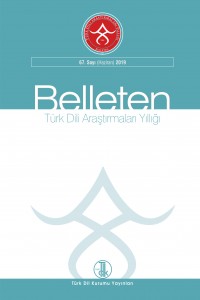Abstract
References
- Apaydın, T. (1966). Toprağa basınca. İstanbul: Arkın. (=TB)
- Ayverdi, S. (2007). Ne idik ne olduk. İstanbul: Kubbealtı. (=NİNO)
- Banarlı, N.S. (2007). Edebiyat sohbetleri. İstanbul: Kubbealtı. (=ES)
- Emiroğlu, Ö. (2001). Hisar’da kültür ve sanat konuşmaları. Ankara: Kültür Bakanlığı.(=HKSK)
- Tamer, R. (1988). Pazar kahvesi. Birkaç resim, birkaç isim. İstanbul: Toker. (=PK)
Abstract
The compound tense of Urmia dialect was shaped according to linguistic
area of its origin, language contacts and its distinctive system.
There are perfect and narrative forms of verbs with compound tense in
Urmia dialect. There is perfect compound inflection of all tenses except
the perfect tense and imperatives. Narrative compound tense is only
seen in third persons. The conditional of verbs with compound tense
hasn’t remained in Urmia dialect. Instead of this, the similar structures
from Persian are used.
-(y)(A)rdlA(r) form in Urmia dialect is used for present perfect tense.
This form is originated from syllabification function. When -(y)(A)
rdIlAr form is attached to the verbs, /ı/ ~ /i/ vowels fall in the open
syllable containing the suffix -dI. Remaining -d element is added to the
previous syllable as it doesn’t make a syllable. There is a fragmentation
as -(y)(A)rd-lA(r) in monosyllable verbs ending with a vowel and as
-(KV)rd-lA(r) by taking the last suffix of verb in multisyllable verbs
ending with a vowel. Also, there is a fragmentation as -(K)Ard-lA(r) by
adding the last consonant of verb into the syllable. As a result, a syllable
occurs in consonant-vowel-consonant-consonant format. This syllable
takes on the emphasis in the word.
References
- Apaydın, T. (1966). Toprağa basınca. İstanbul: Arkın. (=TB)
- Ayverdi, S. (2007). Ne idik ne olduk. İstanbul: Kubbealtı. (=NİNO)
- Banarlı, N.S. (2007). Edebiyat sohbetleri. İstanbul: Kubbealtı. (=ES)
- Emiroğlu, Ö. (2001). Hisar’da kültür ve sanat konuşmaları. Ankara: Kültür Bakanlığı.(=HKSK)
- Tamer, R. (1988). Pazar kahvesi. Birkaç resim, birkaç isim. İstanbul: Toker. (=PK)
Details
| Primary Language | Turkish |
|---|---|
| Journal Section | Research Article |
| Authors | |
| Publication Date | June 1, 2019 |
| Published in Issue | Year 2019 Issue: 67 |

